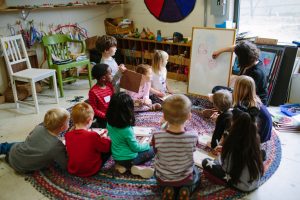 Prekindergarten and kindergarten Primary students love coming to the art studio once a week in the afternoon. Although I am a huge fan of process art where the process of creating is the main focus, I have discovered directed drawing also has its place. At the beginning of class, students meet me on the rug to watch as I draw shapes and lines that turn into an object they can recognize. Then it is their turn to draw. Students have clipboards with drawing paper attached. They follow along as I draw one line (or shape) at a time. Through this directed process, they are learning to find the lines and shapes in things that they see. Then is the fun part when they go to the table and finish their picture with watercolors, oil pastels, colored pencils etc.
Prekindergarten and kindergarten Primary students love coming to the art studio once a week in the afternoon. Although I am a huge fan of process art where the process of creating is the main focus, I have discovered directed drawing also has its place. At the beginning of class, students meet me on the rug to watch as I draw shapes and lines that turn into an object they can recognize. Then it is their turn to draw. Students have clipboards with drawing paper attached. They follow along as I draw one line (or shape) at a time. Through this directed process, they are learning to find the lines and shapes in things that they see. Then is the fun part when they go to the table and finish their picture with watercolors, oil pastels, colored pencils etc.
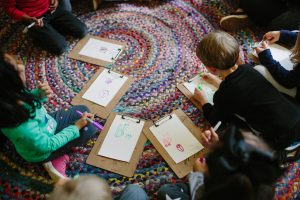 What about students who think they have a hard time drawing? I am constantly reminding all out students how the art studio is a safe place to experiment, and we don’t worry about being perfect. You might hear me saying, “perfect is boring!” Directed drawing breaks down an object into simple lines and shapes, which helps ensure our students' earliest art experiences are positive (so hopefully they will continue loving art as they grow older). Plus, Greensboro Montessori School students are great at asking for help if they feel they need it. As a teacher guide, I am there to encourage and assist when a child asks for help, but I mostly see the students growing in their confidence and having fun as they practice drawing.
What about students who think they have a hard time drawing? I am constantly reminding all out students how the art studio is a safe place to experiment, and we don’t worry about being perfect. You might hear me saying, “perfect is boring!” Directed drawing breaks down an object into simple lines and shapes, which helps ensure our students' earliest art experiences are positive (so hopefully they will continue loving art as they grow older). Plus, Greensboro Montessori School students are great at asking for help if they feel they need it. As a teacher guide, I am there to encourage and assist when a child asks for help, but I mostly see the students growing in their confidence and having fun as they practice drawing.
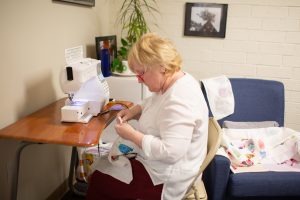 Examples of Primary students' directed drawings were on display at the 2019 Green & White Bash. I worked with YoungDoo Carey on creating an art series based on the four seasons. Students drew snowmen for winter, flowers for spring, ladybugs for summer, and leaves for fall. I gave selected drawings to YoungDoo, who digitized the drawings and created patterns for printing on fabric. YoungDoo then worked with Anne Schroth, owner of Red Canary Studios and a former Greensboro Montessori School parent, to print the patterns on various fabrics. Heather Goggin then used the fabric to create pillows, linen tea towels, and scarves.
Examples of Primary students' directed drawings were on display at the 2019 Green & White Bash. I worked with YoungDoo Carey on creating an art series based on the four seasons. Students drew snowmen for winter, flowers for spring, ladybugs for summer, and leaves for fall. I gave selected drawings to YoungDoo, who digitized the drawings and created patterns for printing on fabric. YoungDoo then worked with Anne Schroth, owner of Red Canary Studios and a former Greensboro Montessori School parent, to print the patterns on various fabrics. Heather Goggin then used the fabric to create pillows, linen tea towels, and scarves.
While process art is at the heart of my teaching, I am finding a balance using both process art and directed drawing. Teaching both techniques is the best way to follow the child.

Katherine Gwynn is the visual arts faculty for Primary, Lower Elementary, and Upper Elementary students. She is a mixed-media artist and her art studio is filled with a variety of materials for creating. Students in her classes are exposed to a wide variety of media, art styles and movements, specific artists, and terminology. She often supports the CASA program with enrichment activities, and in addition to her regular class, she maintains open studio time for Upper School students who are often engaged in elaborate projects. Katherine holds two bachelor's degrees: one in interdisciplinary studies in art and design from the University of North Carolina at Chapel Hill and another in social work from the University of North Carolina at Greensboro.
 For this year’s Green and White Bash, Upper Elementary students took inspiration from the beauty and complexity of Greensboro Montessori School's gardens. As one of the room parents in Upper Elementary (my daughter, Stella, is a sixth-year student), I had the opportunity to work with my fellow room parents, Catherine Wolfe and Flory Hénon, to develop the classroom auction project. We chose to invite a collaboration between Environmental Education, Visual Art, and Upper Elementary to celebrate spring and to honor the spirit of Maria Montessori’s words about the importance of building a connection between children and nature. In 1936, Montessori wrote in The Secret of Childhood:
For this year’s Green and White Bash, Upper Elementary students took inspiration from the beauty and complexity of Greensboro Montessori School's gardens. As one of the room parents in Upper Elementary (my daughter, Stella, is a sixth-year student), I had the opportunity to work with my fellow room parents, Catherine Wolfe and Flory Hénon, to develop the classroom auction project. We chose to invite a collaboration between Environmental Education, Visual Art, and Upper Elementary to celebrate spring and to honor the spirit of Maria Montessori’s words about the importance of building a connection between children and nature. In 1936, Montessori wrote in The Secret of Childhood:
"There must be provision for the child to have contact with nature, to understand and appreciate the order, the harmony and the beauty in nature … so that the child may better understand and participate in the marvelous things which civilization creates."
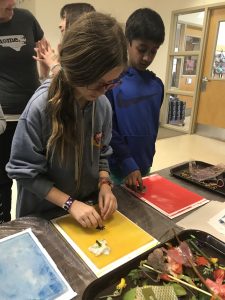 Our exploration of “the harmony and the beauty in nature” took the form of a printmaking workshop. Using gelatin plates, soy-based inks, found objects, and baskets of garden finds, we experienced nature’s beauty and fragility firsthand through art-making. Gelatin (also called “gel” or “gelli”) printmaking is a fun and safe monotype printing method used by both professional artists and weekend crafters. It is particularly well-suited to children, because gel plates and the water-soluble inks used in the printing process are nontoxic. It is also easy to achieve beautiful results, because the gel material is spongy and shows even small details of the objects being printed.
Our exploration of “the harmony and the beauty in nature” took the form of a printmaking workshop. Using gelatin plates, soy-based inks, found objects, and baskets of garden finds, we experienced nature’s beauty and fragility firsthand through art-making. Gelatin (also called “gel” or “gelli”) printmaking is a fun and safe monotype printing method used by both professional artists and weekend crafters. It is particularly well-suited to children, because gel plates and the water-soluble inks used in the printing process are nontoxic. It is also easy to achieve beautiful results, because the gel material is spongy and shows even small details of the objects being printed.
Our printmaking day began in the morning with Eliza Hudson, Greensboro Montessori School’s lead environmental educator, taking several student volunteers into the Upper Elementary garden to collect fresh materials. They gathered an exciting assortment of flowers and herbs bursting with the colors and textures of spring. Later in the morning, I arrived to set up our printmaking workshop. As I prepared the area for working, many curious students stopped by to see what was happening. Some poked at the squishy plates; others picked through the assortment of materials on display. I enjoyed seeing their curiosity piqued, even though we had yet to begin the actual printmaking. Catherine arrived soon after me, and together we inked each of three gel plates with a different color. We chose deep blue, reddish-pink, and an ochre yellow — all the way around the color wheel! — to represent the wide spectrum of colors found in nature. Once everything was ready to go, the teachers sent us groups of students by grade level during their recess.
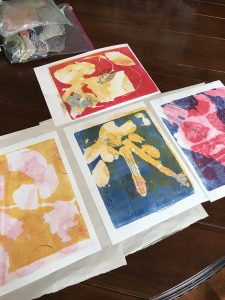 The sixth-grade students arrived first. They were quick to organize themselves: three students lined up in front of the gel plates while the other students crowded around to watch. They chose garden materials and recycled objects, then arranged them into compositions on the inked plates. We took preliminary prints, with the objects still on the plates, that resulted in strong, saturated colors and amorphous drifts of white left behind where the objects blocked the ink. We discovered that these prints made perfect background layers for prints taken of the detailed images left in the ink once the objects were removed. Sometimes enough ink remained on a plate after pulling these two prints to allow for a third “ghost” print that the students could use as yet another layer. In this way, each final print was created as the result of multiple rounds of printing through student collaboration. The shapes and colors on each print intertwined to create a beautiful and organic complexity, mimicking that which is found in nature. The students enjoyed the process of working together with their fellow students, and over time, began to design their prints collectively, keeping all of the layering possibilities in mind.
The sixth-grade students arrived first. They were quick to organize themselves: three students lined up in front of the gel plates while the other students crowded around to watch. They chose garden materials and recycled objects, then arranged them into compositions on the inked plates. We took preliminary prints, with the objects still on the plates, that resulted in strong, saturated colors and amorphous drifts of white left behind where the objects blocked the ink. We discovered that these prints made perfect background layers for prints taken of the detailed images left in the ink once the objects were removed. Sometimes enough ink remained on a plate after pulling these two prints to allow for a third “ghost” print that the students could use as yet another layer. In this way, each final print was created as the result of multiple rounds of printing through student collaboration. The shapes and colors on each print intertwined to create a beautiful and organic complexity, mimicking that which is found in nature. The students enjoyed the process of working together with their fellow students, and over time, began to design their prints collectively, keeping all of the layering possibilities in mind.
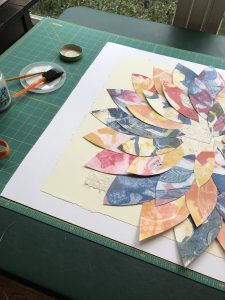 Upper Elementary students of all levels enjoyed the activity and many wanted to spend additional time making prints. I loved watching their faces as they pulled a fresh print off the plate. Their eyes would grow with excitement, and occasionally I’d even hear a gasp. The teachers were equally fascinated by the process. Katherine Gwynn, Greensboro Montessori School’s visual arts faculty, along with Eliza and the Upper Elementary faculty visited to observe and participate. Cathy Moses took photos and John Archambault partnered with a student to make a set of prints. When all of the students were finished with their work, we cleaned the area, and I packed up the prints to take home. In my studio, I combined and transformed them into the petals of a large, three-dimensional flower — a nuanced and strikingly beautiful tribute to spring that showcases the diversity found in nature and also among the children who dwell in it here at Greensboro Montessori School.
Upper Elementary students of all levels enjoyed the activity and many wanted to spend additional time making prints. I loved watching their faces as they pulled a fresh print off the plate. Their eyes would grow with excitement, and occasionally I’d even hear a gasp. The teachers were equally fascinated by the process. Katherine Gwynn, Greensboro Montessori School’s visual arts faculty, along with Eliza and the Upper Elementary faculty visited to observe and participate. Cathy Moses took photos and John Archambault partnered with a student to make a set of prints. When all of the students were finished with their work, we cleaned the area, and I packed up the prints to take home. In my studio, I combined and transformed them into the petals of a large, three-dimensional flower — a nuanced and strikingly beautiful tribute to spring that showcases the diversity found in nature and also among the children who dwell in it here at Greensboro Montessori School.
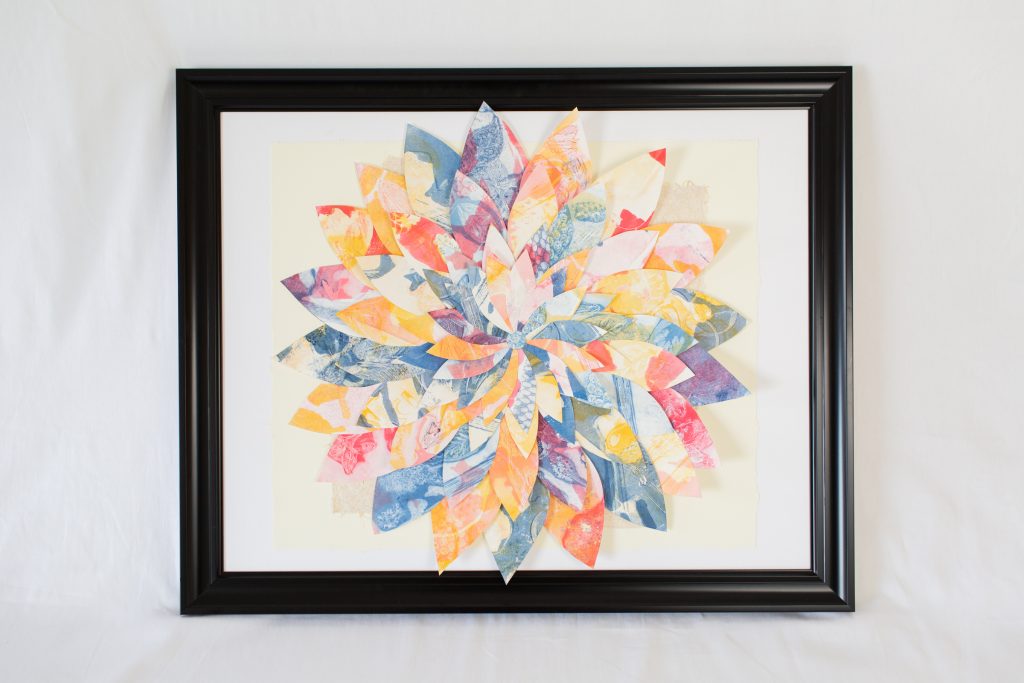
Acknowledgements
This project came together with the help of several important collaborators. First, thank you to Eliza Hudson for taking volunteer students into the garden on a beautiful spring day to collect flowers and herbs, the stars of this project! Thank you also to Katherine Gwynn for her enthusiasm and for placing an emergency order of paper for us. Many thanks to the Upper Elementary teachers, Cathy Moses, John Archambault, and Tessa Kirkpatrick, for weaving our project into a busy school day. And, finally, thank you to my year-long collaborators in Upper Elementary, fellow room parents Catherine Wolfe (who is also the division coordinator) and Flory Hénon, for their excitement about the project and their support during the printmaking workshop.
 About the Author
About the Author
Gina Pruette is a parent and substitute teacher at Greensboro Montessori School. In addition to helping at the School, Gina enjoys tackling creative challenges as a freelance copy editor, writer, and visual artist. She is writing her first book, a guide to collaborative art-making with children, with the hope of encouraging more parents and educators to make art with the children in their lives. This summer, Gina will teach bookbinding methods during the School’s GMS Press book-themed camp. You can find her on Twitter and Instagram. She holds a bachelor of arts from the University of Pennsylvania.
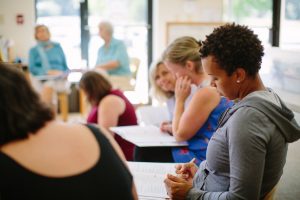 Why is professional development so important at Greensboro Montessori School?
Why is professional development so important at Greensboro Montessori School?
We talk about our students being lifelong learners.
We always want them to discover, to ask questions, to think new things, and to have new thoughts. Especially at a Montessori school, we believe the adults who help guide our students’ education also need to be lifelong learners. We, too, should ask questions and think and try new things, just as we ask our students.
As professional educators, we are always watching for chances to learn: observing students or other teachers, having that unexpected conversation with a colleague, or connecting with professionals and researchers and new theories through more organized professional development — conferences, workshops, speakers, or graduate classes. We spend a lot of resources on professional development because we believe our School is only as good as our professional educators are.
The Montessori Event
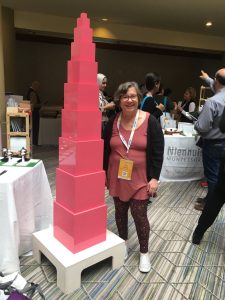 Our crew was quite fortunate to have an amazing professional experience recently. A trip up to Washington, D.C. was the setting …
Our crew was quite fortunate to have an amazing professional experience recently. A trip up to Washington, D.C. was the setting …
For four days 26 faculty and staff from Greensboro Montessori School joined 4,400 other Montessori educators from around the world. We were all there for the American Montessori Society annual international conference. To have 26 of us together at the same place and same time at such a high-quality professional conference is truly spectacular. We thought together, asked questions, learned new things, built community amongst ourselves, and talked about how we further build community amongst our students and families. Being together with the 26 of us allowed for unprecedented synergy; for deep conversations about specific Greensboro Montessori School curricula or programs; for conversations about new ideas for which there's never time in the midst of our normal school days; and for space in our minds and hearts to dream about what we want our School to be. (Oh, yeah, we did laugh a little bit, too.)
A unique opportunity like this allows us, individually, to be better educators, and for us, collectively, to make our School stronger ... ultimately providing a better educational experience for our students. Every professional development workshop or seminar our faculty and staff attend is for the benefit of our students. Our professional development is for our students.
What did we Learn?
Since our time in Washington, D.C., we have already begun to put to use much of what we learned and thought. The turn-around practical value is very high at a conference which is so focused on our exact curriculum and pedagogy. The 26 of us expressed our reflections in a shared space. Here are a few things we wrote:
- "Just when you think you’ve seen it all, someone shows you a new way to use a [Montessori] material. This made me think of other ways I could use the materials..."
- "Something new to start doing is taking more time to create a comfortable, prepared environment; I would like to involve the students more consistently on these decisions..."
- "I’d like to think more project-based learning and how it does fit (perfectly) with Montessori philosophies, especially in the Upper School; I talked with the director of the Riley Institute that does all the Montessori research at Furman University about a new workshop they created about project-based learning, and she said she might be able to come up to Greensboro to give a workshop for us..."
- "Creating an empowering environment for my advisee group [in Junior High]; finding and providing activities that help each [student] to know [their] own strengths and weaknesses..."
- "Our Land program and microeconomy are incredible, everyone else seems to really struggle with [adolescent] programs..."
- "Observation; I had forgotten just how fundamental and essential it is to sit and observe; in order to appreciate this process, it might be helpful for the rest of the team in the classroom to have their own time to observe as well; I remember now that we must make this a priority..."
- "In the storm of adolescence, we must be the calm… Don’t get on the rollercoaster with the students.”
- Some of the titles of our favorite workshops include: “What makes a Secondary Montessori Program Unique?,” “Enhancing Student Engagement in Secondary [Adolescent] Classrooms,” “Critical Partnerships for Children with Exceptionalities,” “Parent Education That Will Keep Them Coming Back For More!,” and “Visual Arts in Socratic Seminar.”
Thank you for supporting our faculty and staff in our own professional development. It only makes us better educators, and our School a better one for our students.
Everything we do, professional development included, is for our students.
Brooke Juneau is a living legend at Greensboro Montessori School. Beloved by her students, families, and fellow members of the Tod Squad (the name our Toddler faculty have affectionately given themselves), Brooke is a servant leader and advocate for children and families.
Brooke is currently the lead teacher in our Academic-Day Toddler classroom, Toddler division chair, and co-chair of our dual reaccreditation with the American Montessori Society (AMS) and Southern Association of Independent Schools. In February, we announced that Brooke will spearhead our after-school and summer programming as our director of CASA beginning in the 2019-20 school year. While Brooke will deeply miss working with our Toddler students and teachers, she plans on visiting the Toddler classrooms often. Plus, as an AMS-credentialed educator in Infant and Toddler Montessori education, Brooke will remain a invaluable resource to our Toddler families and faculty.
As she transitions into the director of CASA role, Brooke is looking forward to expanding her relationships with Primary, Elementary, and Junior High families and reconnecting with many students who began with her in our Toddler program. She’s also patiently waiting (with open arms, of course) for her current Toddler students to grow, transition to Primary, and perhaps join our CASA program.
Professional and Personal Work
Last fall, Brooke presented at the North Carolina Association of Independent Schools annual conference. Her topic was entitled “In this Together: Navigating Difficult Conversations with Families.” The seminar focused on nurturing the positive parent-teacher relationships necessary to successfully guide students through their academic journey.
More recently, Brooke presented at the AMS annual conference, an international conference of over 4,000 Montessori educators. “Partnering with Parents of Children with Special Needs” was a 75-minute workshop, during which she led participants through activities designed to help them better understand the perspectives of parents who have children with developmental, behavioral, and/or learning challenges. She reviewed the distinct stages of grief families may experience after a child’s diagnosis, why communication may be difficult with those families, and ways to frame sensitive, fruitful conversations about children’s needs.
Brooke’s expertise in partnering with families and improving outcomes for children with exceptional needs stems from her personal experience. Brooke and her husband, Jason, have three children. Harper will be in Upper Elementary next year, and Hayden graduated from Greensboro Montessori School in 2017 and is currently a sophomore at Weaver Academy. Their oldest, Riley, is a young adult successfully living and navigating the world with dual diagnoses of autism and Joubert syndrome. Brooke and Jason have personally lived through the stages of grief she reviewed in her AMS presentation and the steadfast work of advocating for Riley and their family.
Education and Career
Brooke has also studied and worked in human development her entire life. She holds a Bachelor of Arts in education and human development and has completed graduate coursework in early childhood education at Wheelock College. She also completed a rigorous one-year, graduate-level program to earn her AMS teaching credential.
Brooke began her teaching career managing early childhood programs in the Boston and Raleigh areas. Immediately prior to joining Greensboro Montessori School, Brooke worked for eight years as a parent liaison at the Family Support Network of Central Carolina, where she personally assisted families in finding and accessing services, support groups, school advocacy, and other needed resources for their children with special needs. She also trained and managed volunteers to serve as parent matches for families whose children were newly diagnosed.
Get to know Brooke
If you haven’t had the pleasure of reading a newsletter or progress report written by Brooke, you’re missing out on one of her other talents. Brooke is a prolific and exquisite writer, capturing the beauty of children, the prepared environment, and the everyday occurrences when the two interact — just as they should in a Montessori classroom.
While there is so much more to Brooke, we encourage you to form your own relationship with this master teacher and parent. Just like all our faculty and administrators, Brooke is available via email or by calling the Front Office at 336-668-0119.



